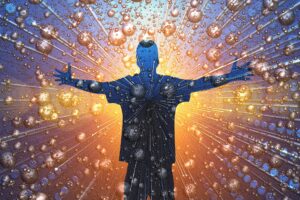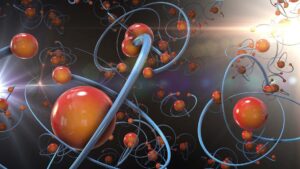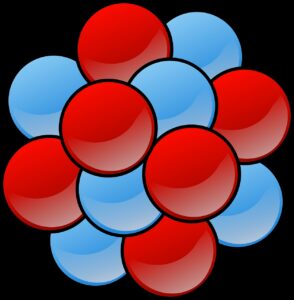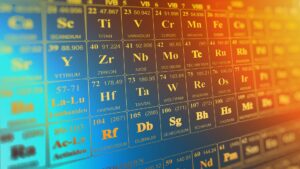
Everything in the universe is made of atoms
Firstly, to all the people out there who are thinking, “are atoms and particles the same?”
Particles can be atoms, molecules, or ions while atoms are single neutral particles.
That gets us to the beginning of facts and statistics about atoms and particles.
Atoms and particles: is there a difference?
The main difference between atoms and particles is that atoms are small units consisting of different particles.
How smaller is the size ‘small’?
According to the data in hands, very SMALL!

Thousands of atoms could be placed across a human hair
For example, take the width of human hair. With the help of a microscope, one can look inside the hair and find cells. These cells formed from molecules are products of a collection of atoms. One can fit 1000 atoms across a human hair.

Scattered particles
What are particles?
Everything in the universe consists of matter, which our scientists named ‘particles’.

Atom
What is an atom?
Everything in the universe apart from energy consists of matter and thus atoms constitutes everything in the universe. That is, from asteroids to planets, to you, and the technology in front of you is made of atoms. The very term ‘atom’ hails from the Greek word for ‘uncuttable’ or ‘undivided’.
Why the word undivided or uncuttable?
The name derives from the Greek philosopher Democritus of the 5th century BC. He believed that matter consisted of particles which are further not possible to divide into smaller particles.
Does it?
Now, studies have stated that atoms have the capacity to divide into smaller particles. They are protons, neutrons, and electrons. Known as subatomic particles they have even smaller particles called quarks.

The Big Bang
The atomic history: Facts and Statistics
Ever heard about the Big bang? The event gave rise to our universe approximately about 13.7 billion years ago.
Atoms were the creation of the Big Bang that is, 13.7 billion years ago. Yes, they are that old!
According to the data presented by the scientist, the formation of quarks and electrons occurred after the big bang. Further, quarks came together in the formation of protons and neutrons. Later these particles together combined to form nuclei.
Statistic states that it took almost 380,000 years after the Big Bang for the first atom to form.
The earliest atoms however were helium and hydrogen. They are still the most plentiful elements found in the universe.
John Dalton, considered to be the one who discovered modern atomic theory. However, manuscripts of Acharya Kanada (an Indian physicist over 2500 years ago), are found marking the discovery of atoms.
Acharya Kanada called the invisible atoms as “Parmanu”.
Niels Bohr created ‘The model of the atom’ that is presently accepted worldwide.

Facts and statistics about atoms
- There are over 100 different types of atoms.
- The largest atom, cesium, is about 9 times larger than the smallest atom, helium.
- A total percentage of 74% of galaxy atoms is hydrogen atoms.
- About 92 of the atoms occur naturally. While the remaining are made in the labs.
- The first new atom made by men was technetium.
- Human has around 7 billion billion billion atoms in their body. Yet they replace around 98% of them every year.

Subatomic Particle Facts and Stats
- In 1911, Earnest Rutherford of New Zealand discovered the nucleus.
- James Chadwick, one of Rutherford’s students confirmed Earnest Rutherford’s theory of neutral particles.
- Electrons are exceptionally lightweight as compared to protons and neutrons.
- Protons and neutrons reside in the nucleus, which is at the center of the atom.
- The electrons are light, resident in the orbits of the Nucleus cloud.
- The electron cloud has a 10,000 times greater radius than the nucleus.
- A proton is approximately 1,835 times larger than an electron.
- On the other, protons and neutrons both have approximately equivalent mass.
- Facts about atoms state that they always have an equal number of protons and electrons present.
- Adding a proton to an atom creates a new element.
- Adding a neutron creates an isotope or a heavier version of that atom.
- The strong force that binds together proton neutrons is 1,038 times more powerful than gravity.
- Quarks found inside protons and neutrons are so small that it’s difficult for scientists to measure them.
- Quarks are at least 10,000 times smaller than the nucleus according to the data.

The Periodic Table
Let’s give attention to proton...
As stated earlier, credit for calling the title "proton" goes to Ernest Rutherford. Protons are about 99.86% massive mostly similar to neutrons. The number of protons present in an atom is the atomic number of the particular element. For instance, hydrogen atoms have 1 proton, carbon has 6, and oxygen has 8. Some matter consists of one type of atom, for example, gold. While another matter is made of atoms bonded together in order to form compounds, for instance, sodium chloride.
Besides atomic number, the number of protons also regulates the chemical behavior of the element.
Let’s give attention to neutrons...
According to the historical data, Earnest Rutherford speculated neutrons' existence in 1920. Later, his student, Chadwick discovered it in 1932.
Uncharged particles (neutrons) are present within all atomic nuclei except for hydrogen. As said earlier, the mass of a neutron is slightly larger than that of a proton.
Mere facts about electrons…
- Sir John Thompson discovered it in, 1897.
- As compared to others, the contribution of an electron to the mass is very little.
- It takes around 1,836 electrons to equal the size of a proton.
- Electron orbits so far away from the nucleus that each atom consists of 99.9% empty space.
The nucleus is also important!
- The nucleus is the set of protons and neutrons.
- Extremely dense and contains almost all of the mass of each atom.
- The nucleus held together by the strong force overcomes the repulsive electrical force.
- This repulsive force otherwise pushes the protons apart, giving to the rules of electricity.
- If the atom were the size of a sports arena, its nucleus would be the size of a pea.
- Although much denser, as compared to the rest of the atom, it too consists of empty space.

Particle Physics… what is it?
By taking the facts and statistics about atoms and particles into consideration, in particle physics, the recreation of the Big Bang occurs where particles roam freely in the universe.
The use of powerful particle accelerators accelerates the particles close to the speed of light and then smash them together. This particular experiment helps understand the high-energy collisions that occurred during Big Bang.
Conclusion
Facts and statistics about atoms and particles introduced in the article help us understand atoms and particles which are the beginning of our existence.




